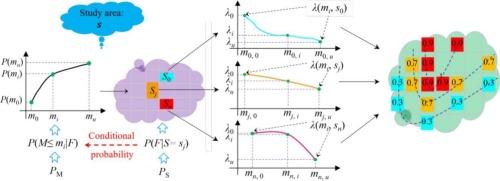Governing relationships of landslide hazard components and the impact on regional landslide hazard predictions
IF 7.2
1区 地球科学
Q1 GEOSCIENCES, MULTIDISCIPLINARY
引用次数: 0
Abstract
Given the hazard prediction of regional landslides, the conditional features feedback from the hazard definition and the independence assumptions adopted by the hazard calculation present a significant contradiction. Although the Copula-based and definition-based models provide the tool for quantitative hazard, it does not fully capture the conditional information in the hazard definition. This study highlights the governing relationships among landslide hazard components, and further introduces a calibrated model that incorporates landslide time as a variable, and space and magnitude as parameters. Finally, the Heilongjiang area was applied to test and compare the performance between the calibrated and classical models. Results show that the classical model may underestimate the landslide hazard. In detail, the maximum hazard generated by the calibrated model is near 1.00 with the increasing time, larger than that of the classical model, 0.64 for the scenario of V > 100 m3, and 0.26 for the scenario of V > 500 m3. Thus, the calibrated model not only considers the relationship among the landslide time, magnitude, and the space but can reach the upper boundary of the probability with the increasing time. This study provides an exploration to develop a more accurate technique for quantifying the regional landslide hazard.

滑坡灾害分量的控制关系及其对区域滑坡灾害预测的影响
在区域滑坡危险性预测中,由危险性定义反馈的条件特征与危险性计算所采用的独立性假设存在明显的矛盾。尽管基于copula和基于定义的模型提供了定量危险的工具,但它不能完全捕获危险定义中的条件信息。在此基础上,提出了以滑坡时间为变量,以滑坡空间和震级为参数的校准模型。最后,以黑龙江地区为例,对标定模型与经典模型的性能进行了检验和比较。结果表明,经典模型可能低估了滑坡的危险性。其中,校正模型产生的最大危害随着时间的增加接近1.00,大于经典模型,在V >; 100 m3情景下产生的最大危害为0.64,在V >; 500 m3情景下产生的最大危害为0.26。因此,校正后的模型不仅考虑了滑坡时间、震级和空间的关系,而且随着时间的增加能够达到概率的上界。本研究为建立更准确的区域滑坡灾害量化方法提供了探索。
本文章由计算机程序翻译,如有差异,请以英文原文为准。
求助全文
约1分钟内获得全文
求助全文
来源期刊

Gondwana Research
地学-地球科学综合
CiteScore
12.90
自引率
6.60%
发文量
298
审稿时长
65 days
期刊介绍:
Gondwana Research (GR) is an International Journal aimed to promote high quality research publications on all topics related to solid Earth, particularly with reference to the origin and evolution of continents, continental assemblies and their resources. GR is an "all earth science" journal with no restrictions on geological time, terrane or theme and covers a wide spectrum of topics in geosciences such as geology, geomorphology, palaeontology, structure, petrology, geochemistry, stable isotopes, geochronology, economic geology, exploration geology, engineering geology, geophysics, and environmental geology among other themes, and provides an appropriate forum to integrate studies from different disciplines and different terrains. In addition to regular articles and thematic issues, the journal invites high profile state-of-the-art reviews on thrust area topics for its column, ''GR FOCUS''. Focus articles include short biographies and photographs of the authors. Short articles (within ten printed pages) for rapid publication reporting important discoveries or innovative models of global interest will be considered under the category ''GR LETTERS''.
 求助内容:
求助内容: 应助结果提醒方式:
应助结果提醒方式:


